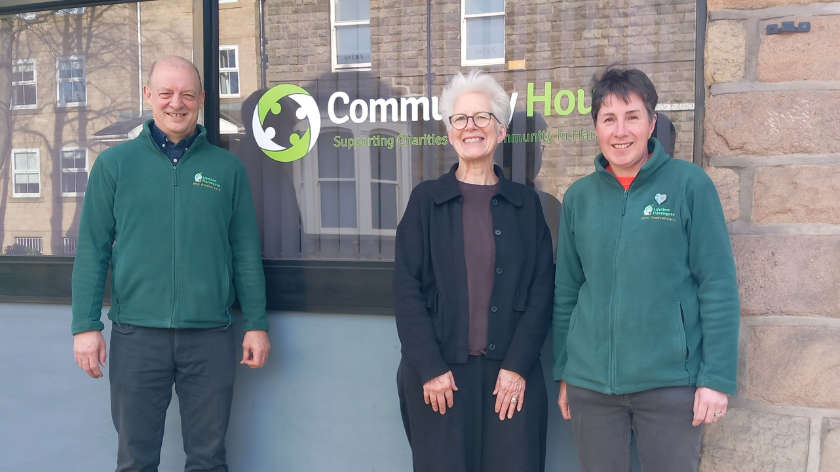
Councillors approved the 1,300-home Clotherholme scheme in Ripon today after receiving assurances they will have the final say on what happens to the site's historic military structures that were used in both world wars.
Councillors approved the 1,300-home Clotherholme scheme in Ripon today after receiving assurances they will have the final say on what happens to the site’s historic military structures that were used in both world wars.
The government’s housing agency Homes England is behind the development which also includes a new primary school, sports pitches, retail, food and drink units and a 60-bed care home.
30% of the homes will be classed as affordable.
Ripon’s barracks are still used by the Royal Engineers and consists of Deverell Barracks to the east, Claro Barracks to the west and Laver Banks to the south.

The army is expected to fully vacate the site in the second half of this decade to make way for the development.
Councillors on North Yorkshire Council’s strategic planning committee met in Northallerton earlier to consider giving outline permission.
Since the scheme was first mooted several years ago there has been much discussion in the city about what will happen to some of the site’s structures, which includes training huts that were used to prepare for the D-Day landings in World War II.
Councillors heard that a heritage strategy costing £100,000 will help Homes England investigate whether a viable scheme can be developed to retain the military buildings.
However, heritage expert Guy Wilson from Ripon Military Heritage Trust said he was sceptical that this would lead to protection for the buildings. He said approving the plans would not guarantee they would be saved and could “doom” them.
Mr Wilson said:
“Success [on D-Day] was in no small part due to testing and experimenting at the site in Ripon.
"What happened there affected the tactics and equipment of British allied forces. All heritage on this site matters, not just locally but internationally.”
David Rowlinson from Homes England spoke to say representatives had met with the trust on 14 occasions to discuss how to save the buildings.
But he said the proposals for retaining them put forward by the trust would make the scheme undeliverable.
An updated design guide submitted by the developer suggests a “number of buildings” could now be retained within the site on an area of Laver Banks that is “themed on the celebration of the important role that Ripon has played in supporting armed forces, including a trim trail that references the military version on site.”
Stephen Harness from the Defence Infrastructure Organisation, which is part of the Ministry of Defence, pledged that the site’s military history will be included in the development but he did not give specific details.
He added:
“The existing community of Ripon will walk the site and be able to connect it to the past.”
Concerns about the scheme’s impact on local roads were also raised by both Cllr Barbara Brodigan (Liberal Democrat, Ripon Ure Bank & Spa) and Cllr Andrew Williams (Conservative and Independents Group, Ripon Minster & Moorside).
Cllr Williams referred to the plan to ban right-turning traffic on the Low Skellgate/Somerset Row junction, which he said would cut current residents off and force them to take a longer route to get to their homes.
In response, council planning officer Nick Turpin said he was satisfied that any changes to the road network have been underpinned by modelling and research.
He said:
“We need to have an evidence-based approach to these things and rigorous evidence suggests it should be alright.”
Several councillors said they wanted to see tougher planning conditions attached to ensure that some of the military buildings are saved as part of the strategy, which could take months or even years to finalise.
Cllr Tom Jones (Conservative, Scotton & Lower Wensleydale) asked if councillors could have the final say on the strategy, rather than it being decided by council officers behind closed doors.
Cllr John McCartney (Independent, Osgoldcross) added that he was concerned that the strategy could be “stitched up” without the input of elected members.
A council solicitor confirmed that it would be possible for the planning committee to either approve or refuse the heritage strategy at a future meeting.
A condition stating this was attached to the application which was then approved unanimously.



 Harrogate dog show to include new pet-themed market
Harrogate dog show to include new pet-themed market
 Leeds Bradford Airport launches new flights to Palma and Malaga
Leeds Bradford Airport launches new flights to Palma and Malaga
 New floral artwork unveiled across Harrogate town centre
New floral artwork unveiled across Harrogate town centre
 80 Easter eggs collected for Knaresborough special needs school
80 Easter eggs collected for Knaresborough special needs school
 Baby giraffe born at Flamingo Land
Baby giraffe born at Flamingo Land
 YMCA Ripon to host charity sleep out
YMCA Ripon to host charity sleep out
 Saltergate girls' football team: A journey of triumph and opportunity
Saltergate girls' football team: A journey of triumph and opportunity
 Himalayan Garden & Sculpture Park unveils 70 new artworks
Himalayan Garden & Sculpture Park unveils 70 new artworks
 Harrogate vet receptionist tackles London Marathon to help horses
Harrogate vet receptionist tackles London Marathon to help horses
 Programme revealed for Harrogate crime writing festival
Programme revealed for Harrogate crime writing festival
 Hundreds take on inflatable wipeout challenge in Harrogate
Hundreds take on inflatable wipeout challenge in Harrogate
 Wider ban on heather burning 'risks catastrophic wildfires'
Wider ban on heather burning 'risks catastrophic wildfires'
 Over 200 fencers attend Harrogate Fencing Club sporting event
Over 200 fencers attend Harrogate Fencing Club sporting event
 Harrogate homeless charity receives four-figure grant
Harrogate homeless charity receives four-figure grant
 Police appeal after driver fails to stop following A1 collision
Police appeal after driver fails to stop following A1 collision
 Harrogate MP warns 'OFWAT must go' after Yorkshire Water dumps 430,263 hours of sewage
Harrogate MP warns 'OFWAT must go' after Yorkshire Water dumps 430,263 hours of sewage
 Surprise donation pays off debt for Knaresborough Forest Park
Surprise donation pays off debt for Knaresborough Forest Park
 Harrogate woman launches home decluttering business
Harrogate woman launches home decluttering business
 Starbeck dance school to perform at Disneyland
Starbeck dance school to perform at Disneyland
 New ride unveiled at Lightwater Valley near Ripon
New ride unveiled at Lightwater Valley near Ripon








